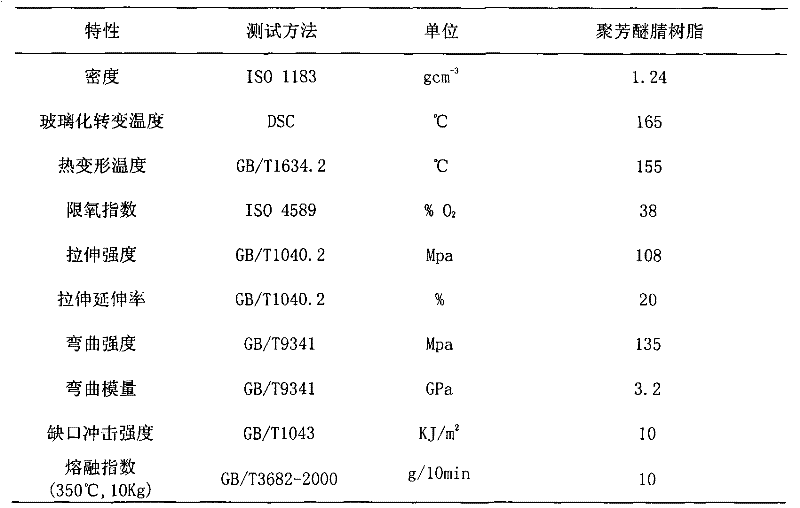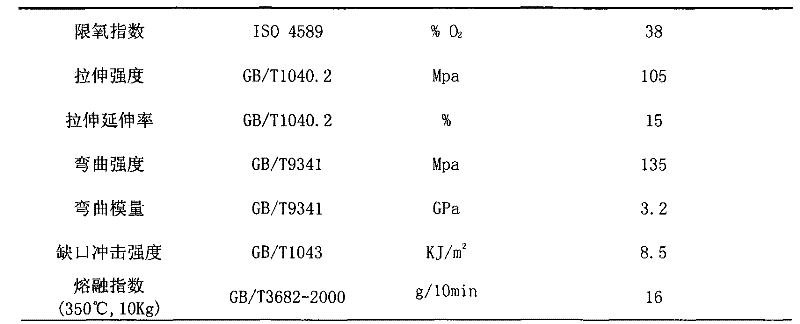Method for preparing poly(arylene ether nitrile) resin
A technology of polyarylether nitrile and resin, which is applied in the field of preparation of polyarylether nitrile resin, can solve the problems of solvent not being recovered and recycled by rectification, high reaction temperature and pressure, and limited application range of resin, etc., to overcome side effects Effects of reactions and by-products, stable performance, and easy-to-achieve production conditions
- Summary
- Abstract
- Description
- Claims
- Application Information
AI Technical Summary
Problems solved by technology
Method used
Image
Examples
Embodiment 1
[0022] According to the following molar ratio: 2,6-dichlorobenzonitrile: hydroquinone: resorcinol: anhydrous potassium carbonate: N-methylpyrrolidone: toluene = 1: 0.9: 0.1: 1.2: 6: 1.3 Weigh the raw materials and put them into the reaction kettle, heat and stir to 140°C for dehydration reaction, during the dehydration reaction process, the water generated by the reaction is separated by the reflux device, and the toluene is refluxed; after the dehydration reaction for 2 hours, the reaction system is heated to 200°C under normal pressure The N-methylpyrrolidone solvent injected into the reactor dilutes the solution until the polymer climbing rod phenomenon occurs during the polymerization reaction until the viscosity of the solution is less than 2000 centipoise. The diluted solution system is sprayed into a precipitation tank with a precipitating agent in a pressurized spraying manner, then heated and stirred, fully refluxed and separated from solid and liquid by a centrifuge, ...
Embodiment 2
[0026] According to the following molar ratio: 2,6-dichlorobenzonitrile: biphenol: anhydrous potassium carbonate: N-methylpyrrolidone: toluene = 1: 1: 1.3: 7: 1.4 Weigh the raw materials and put them into the reactor During the dehydration reaction, heat and stir to 150°C for dehydration reaction. During the dehydration reaction, the water generated by the reaction is separated by the reflux device, and the toluene is refluxed; after the dehydration reaction for 3 hours, the temperature of the reaction system is raised to 200°C, and the polymerization reaction is carried out under normal pressure until polymers appear. When the rod climbing phenomenon occurs, the N-methylpyrrolidone solvent injected into the reactor dilutes the solution until the viscosity of the solution is less than 2000 centipoise. The diluted solution system is sprayed into a precipitation tank with a precipitating agent in a pressurized spraying manner, then heated and stirred, fully refluxed and separated...
Embodiment 3
[0031] According to the following molar ratio: 2,6-dichlorobenzonitrile: bisphenol A: anhydrous potassium carbonate: N-methylpyrrolidone: toluene = 1: 1: 1.2: 6: 1.3 Weigh the raw materials and put them into the reaction kettle , heated and stirred to 140°C for dehydration reaction. During the dehydration reaction, the water generated by the reaction was separated by the reflux device, and the toluene was refluxed; When rod phenomenon occurs, the N-methylpyrrolidone solvent injected into the reactor dilutes the solution until the solution viscosity is less than 2000 centipoise. The diluted solution system is sprayed into a precipitation tank with a precipitating agent in a pressurized spraying manner, then heated and stirred, fully refluxed and separated from solid and liquid by a centrifuge, and the separated liquid is sent to a rectification tower to rectify and recover the solvent In order to be recycled; the separated solid is firstly washed and filtered with acidic boilin...
PUM
| Property | Measurement | Unit |
|---|---|---|
| glass transition temperature | aaaaa | aaaaa |
| decomposition temperature | aaaaa | aaaaa |
| tensile strength | aaaaa | aaaaa |
Abstract
Description
Claims
Application Information
 Login to View More
Login to View More - R&D
- Intellectual Property
- Life Sciences
- Materials
- Tech Scout
- Unparalleled Data Quality
- Higher Quality Content
- 60% Fewer Hallucinations
Browse by: Latest US Patents, China's latest patents, Technical Efficacy Thesaurus, Application Domain, Technology Topic, Popular Technical Reports.
© 2025 PatSnap. All rights reserved.Legal|Privacy policy|Modern Slavery Act Transparency Statement|Sitemap|About US| Contact US: help@patsnap.com



